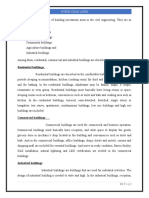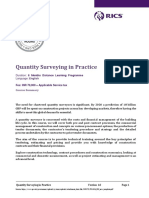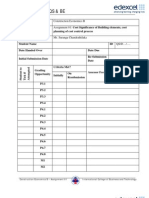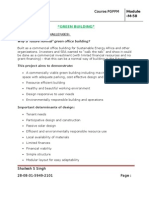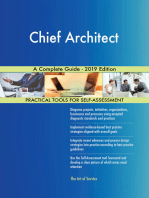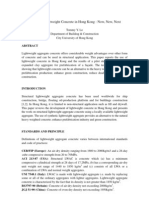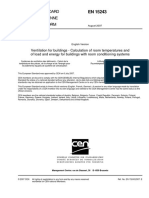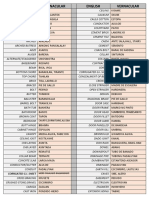0 ratings0% found this document useful (0 votes)
40 viewsGreen Schools
Green Schools
Uploaded by
mnt6176The document summarizes three green building rating systems - LEED, Green Globes, and FGBC - that can be used for green school design in Florida.
LEED is a comprehensive system with high certification costs but provides thorough guidance. Green Globes uses an online survey tool and has lower costs. FGBC focuses on Florida-specific standards and evaluates projects for compliance with its rating categories. Each system requires registering projects and paying fees to achieve certification.
Copyright:
© All Rights Reserved
Available Formats
Download as PDF, TXT or read online from Scribd
Green Schools
Green Schools
Uploaded by
mnt61760 ratings0% found this document useful (0 votes)
40 views7 pagesThe document summarizes three green building rating systems - LEED, Green Globes, and FGBC - that can be used for green school design in Florida.
LEED is a comprehensive system with high certification costs but provides thorough guidance. Green Globes uses an online survey tool and has lower costs. FGBC focuses on Florida-specific standards and evaluates projects for compliance with its rating categories. Each system requires registering projects and paying fees to achieve certification.
Original Description:
Green Schools Design
Copyright
© © All Rights Reserved
Available Formats
PDF, TXT or read online from Scribd
Share this document
Did you find this document useful?
Is this content inappropriate?
The document summarizes three green building rating systems - LEED, Green Globes, and FGBC - that can be used for green school design in Florida.
LEED is a comprehensive system with high certification costs but provides thorough guidance. Green Globes uses an online survey tool and has lower costs. FGBC focuses on Florida-specific standards and evaluates projects for compliance with its rating categories. Each system requires registering projects and paying fees to achieve certification.
Copyright:
© All Rights Reserved
Available Formats
Download as PDF, TXT or read online from Scribd
Download as pdf or txt
0 ratings0% found this document useful (0 votes)
40 views7 pagesGreen Schools
Green Schools
Uploaded by
mnt6176The document summarizes three green building rating systems - LEED, Green Globes, and FGBC - that can be used for green school design in Florida.
LEED is a comprehensive system with high certification costs but provides thorough guidance. Green Globes uses an online survey tool and has lower costs. FGBC focuses on Florida-specific standards and evaluates projects for compliance with its rating categories. Each system requires registering projects and paying fees to achieve certification.
Copyright:
© All Rights Reserved
Available Formats
Download as PDF, TXT or read online from Scribd
Download as pdf or txt
You are on page 1of 7
GREEN SCHOOL DESIGN
(Revision no.1, Dated 07/14/2010)
I. Introduction:
Public school facilities must be designed and constructed to be efficient, effective,
and sustainable for their expected building life. Section 255.2575, Florida Statutes,
requires all school district, college, and university buildings to be constructed to meet
the requirements of one of the three green building standards approved by the
Department of Management Services. In response to this statutory requirement, the
Florida Department of Management Services, requires that state-owned facilities
meet the same standards required in the private sector.
The three models of compliance: United States Green Building Council (USGBC)
Leadership in Energy and Environmental Design (LEED), Green Building Initiative
(GBI) Green Globes rating system, Florida Green Building Coalition Standards
(FGBC), or a nationally recognized, high-performance green building rating system
as approved by the Department of Management Services.
Each school district or college, after much consideration, shall select a model for
each facilitys project to follow. Each model requires the assistance of a registered
design professional to direct the project in accordance with the selected models
measurement criteria. The model chosen by the school district or college must have
a unit of measurement that ensures efficiency, effectiveness (outcomes), and
conversion of the defined objectives and frequently subjective standards to meet the
models application. Each model will lend itself to adaptation with school district and
college dynamics to varying degrees.
The school district or college organizational structures shall be set up to include all
necessary decision makers in accordance with the model selected for the green
school design. The model selected shall consider that all Floridas public schools
must be built of Type I, II, or IV construction, precluding the application of
combustible materials.
II. Summary of State-Approved Methods:
A. (USGBC) LEED Rating System: LEED is an acronym that stands for
Leadership in Energy and Environmental Design. USGBC refers to the
United States Green Building Council. The USGBC Web site is
www.usgbc.org. Information concerning organizational membership is
accessible online at: www.usgbc.org.
This model of green building standard is well assembled and organized.
According to this model there are six basic areas of consideration for
achieving a green school status: Sustainable Sites, Water Efficiency, Energy
and Atmosphere, Materials and Resources, Indoor Environmental Quality,
and Innovation and Design Process. There are four different levels of
achievement; based on assessment points for each facility, certified, silver,
gold, and platinum.
Costs to obtain organizational membership, a level of achievement for each
school building, and a method to maintain or improve the facilities level of
certification may easily total thousands of dollars, which can be offset in
operational savings benefits to the owner of the facility. The LEED online
Web page provides a Schools Reference Guide that explains how to
achieve various levels of facility certification. Each area of consideration is
thoroughly explained, definitions for technical terms are provided, and
assessment points are based on certification ratings in each area of
consideration. Also, information resources for each area of consideration are
given with Web sites to review pertinent standards. USGBC estimates that
the cost to merely register and certify a facility is an average of $5,500 for
new facilities and $3,500 for existing facilities, not including facility
improvements.
This model is easy to follow, and offers comprehensive and pertinent
coverage of applicable information, but cost for membership and facility
certifications is considerable. LEED claims to be a voluntary market-driven
rating system to evaluate green building technology for various buildings. The
LEED model is intended to be comprehensive in coverage but simple in
application. As LEED develops new technology and new materials are
developed, online amendments and notices will be available for review.
B. (GBI) Green Globes Rating System: GBI is an acronym that stands for
Green Building Initiative. Information about GBI is accessible online at
www.greenglobes.com/design.
In 2004, GBI acquired the rights to distribute Green Globes in the United
States. In 2005, the American National Standards Institute (ANSI) accredited
GBI as a standards developer for developing Green Globes as an official
standard under the American National Standard Institute (ANSI). The
standard is written in easy-to-understand terms; no environmental design
experience is needed to use the system. The system requires no training and
is computer-friendly.
Green Globes is focused on reducing the environmental impacts of buildings
based on the following assessment categories: energy, indoor environment,
site, resources, water, emissions and effluents, and project management.
Green Globes provides for the architect, engineer, construction group, and
building owner to determine the methods to reduce operating costs and
enhance the living and working environment for the occupants through the
GBI system.
The Green Globes Tool is an online survey that provides the user with
numerous options, tools, tips, and clarifications for the completion of the
survey. The survey compares seven categories: energy, indoor environment,
site impact, water, resources, emissions, and project management. Based
on the responses submitted, points are assigned and a rating level for the
facility is established. The rating level is based on a percentage.
The report indicates how the facility rates (percentage) and recommends how
to improve scores. The four rating levels that buildings can achieve are: 35-
54%, 55-69%, 70-84%, and 85-100%. The cost to register a facility and use
third-party verification is approximately $5,000 to $7,000, not including the
facility improvements.
C. (FGBC) Florida Green Building Coalition. Information regarding the FGBC is
accessible online at www.floridagreenbuilding.org. For commercial building
information, select Certification at the top of the page, then select
Commercial for the commercial building aspects of FGBC.
The Web page has a vast array of valuable information as it relates to
sustainable economics, and the environmental and social benefits of
providing green building standards. The commercial building standard side of
FGBC focuses on public schools (K-12), and Group B occupancies for
educational facilities over grade 12 (i.e., colleges), as listed in the Florida
Building Code. The FGBC standard is used to adopt environmental
strategies during the design and construction phases of a project so that the
facility can be recognized for its efforts.
The standard recognizes seven categories: energy, water, site, health,
materials, disaster mitigation, and general values. A total of 100 possible
points can be generated for each category. The project team reviews all
categories to determine what credits to target and how many points are to be
pursued for the project. When all paper work is completed by the submitting
designee, the application fees are determined, and payment is forwarded to
FGBC, then the FGBC appoints an evaluator to begin his/her review of the
project. The processing fees are based on building size (square footage) and
the fees vary from $3,000 to $6,000 for each building, not including
improvements.
The FGBC evaluates the project upon receipt of appropriate fees and
determines whether the project is in compliance with FGBC standards. If the
project is compliant, the FGBC issues a certificate to the designee for use by
the owner. If the project is deemed non-compliant, the designee can correct
the deficiencies and resubmit the project to FGBC.
III. Areas of Design Concern in Public Schools
Some areas of design concern for public schools are listed below; however, the list
does not include all items that a district/college may need to consider when
designing, remodeling, or renovating a facility.
Energy Efficiency: Energy efficiency can be enhanced through energy-saving
activities such as renewable energy solar and wind power; basic changes in day-to-
day operations; proactive maintenance; encouraging new individual behavior as it
relates to energy savings; and encouraging students to apply the lessons of energy-
efficiency methodology in their homes and communities.
Water Efficiency: Water efficiency can be accomplished through conservation of
water usage for cleaning, cooking, washing, and irrigation; the collection and
distribution of rain water for the watering of landscape and the storage of rain water
for later usage; and the treatment and recycling of effluent water for use as irrigation
of the landscape as an alternate source for watering.
Sustainable Site Features: Sustainable landscapes include features native to the
area or region; watershed features that can be used to hold or divert waters away
from the facility; and operational and maintenance enhancements.
Health and Indoor Air Quality: Ventilation systems that are appropriate for the region;
lighting (artificial or natural); thermal insulated building envelope and high-efficiency
HVAC comfort systems; implementing better design features and materials;
improving construction performance by maintaining cleaner interiors during
construction; commissioning of the facility; and operating and maintaining the facility
in ways to reduce the indoor pollution while ensuring that fresh air is continually
supplied and properly circulated.
Construction Materials: The use of building materials that are climate-rated for the
construction region in which the facility is erected should be considered. The
recycling of building contents, the re-use of demolition materials or refurbished
existing building materials, and the re-use of demountable partitions and adaptable
interior wall systems should be considered as part of the construction material
selection process. The recycling of demolition materials shall be considered in order
to lessen the impact on the environment.
Disaster Mitigation: How quickly could a district restore a facility back into operation
after a natural disaster such as a hurricane, tornado, wind storm, lightning strike, hail
storm, fire, or a flood event? Policy set forth by the local school/college board should
consider the following: funding source for clean-up, and disaster relief from local,
state, and federal government agencies.
IV District and Community College Policy Options
The District and Community College Policy Options for public schools are listed
below; however, the list is not all-inclusive. A district or college may need to consider
other policy options when designing, remodeling, or renovating a school facility.
Publish goals and objectives for green school designs
Communicate which state-approved method or standard is to be used
Establish an internal evaluation process
In-house school staff training
V. Conclusion
Boards must develop policies to clarify their intent to design and build efficient,
effective, and sustainable public school facilities in accordance with Section
255.2575, Florida Statutes. Through these policies, Florida public schools will
provide cleaner, greener, and healthier learning environments. By making simple yet
effective changes, we can dramatically reduce our carbon footprint and leave a
cleaner, more comfortable earth for future generations.
Benefits to Being a Green School:
Healthy, safe learning environment
High student performance
Increase teacher and support staff satisfaction and retention
Increase attendance by reducing health risks and triggers for asthma
Increase sense of ownership by teachers, staff, students, and parents
Increase connection between the community and school
Prepare students to understand and act on the current and future
environmental challenges
Build partnerships with the local community to design and implement projects
and programs that will result in a healthier environment and safer school
Use of the school buildings and grounds as a teaching tool
Model environmental and conservation best management practices in
building, landscape design, and maintenance can reduce costs
Avoidance of costly repairs
Reduce operating costs
Save money by reducing consumption and operating cost
Protect natural resources
Reduce liability; avoid negative publicity
You might also like
- Pipe and Mechanical Insulation BrochureDocument40 pagesPipe and Mechanical Insulation BrochuresleonNo ratings yet
- International Productivity ListDocument39 pagesInternational Productivity ListDeveloping87% (46)
- 530 ASSIGNMENT (Recovered)Document22 pages530 ASSIGNMENT (Recovered)Moffat KangombeNo ratings yet
- History of The Roles and Responsibilities of Quantity SurveyorDocument9 pagesHistory of The Roles and Responsibilities of Quantity SurveyorFadil Icham JauffurNo ratings yet
- Advantages of Utilizing The Construction EquipmentDocument9 pagesAdvantages of Utilizing The Construction EquipmentShehrezad ManuelNo ratings yet
- Handbook - Fume HoodsDocument137 pagesHandbook - Fume Hoodsmnt6176100% (5)
- Box Culvert BBS FormatDocument3 pagesBox Culvert BBS FormatHemant GaikwadNo ratings yet
- Taipei 101Document6 pagesTaipei 101Gabrielle LagadiaNo ratings yet
- Basement Masonry Wall Design Based On TMS 402-16/13: Input Data & Design SummaryDocument2 pagesBasement Masonry Wall Design Based On TMS 402-16/13: Input Data & Design SummaryRidho ZiskaNo ratings yet
- Code of Practice for Programme Management: In the Built EnvironmentFrom EverandCode of Practice for Programme Management: In the Built EnvironmentNo ratings yet
- My Part Assignment 1Document36 pagesMy Part Assignment 1Adibako Richard D.No ratings yet
- Building Construction EditDocument26 pagesBuilding Construction EditSami Zama100% (1)
- Assignment From Lecture 3Document5 pagesAssignment From Lecture 3J. NawreenNo ratings yet
- Unit 1 Estimation and ValuationDocument42 pagesUnit 1 Estimation and ValuationPrashant Mani PaudelNo ratings yet
- Word File 2 QSC MaterialDocument22 pagesWord File 2 QSC MaterialShakti DubeyNo ratings yet
- China Two Percent), and The Linear Model Is Still Systemically "Baked In"Document5 pagesChina Two Percent), and The Linear Model Is Still Systemically "Baked In"song neeNo ratings yet
- 04 Working Drawings - Module 4Document19 pages04 Working Drawings - Module 4Brian chunguliNo ratings yet
- Sri Vidya College of Engineering & Technology Lecture NotesDocument15 pagesSri Vidya College of Engineering & Technology Lecture NotesIsrael VenkatNo ratings yet
- Modern Quantity SurveyDocument11 pagesModern Quantity SurveygauthamNo ratings yet
- UNIMAS 2019 Faculty of EngineeringDocument24 pagesUNIMAS 2019 Faculty of EngineeringlingNo ratings yet
- Construction Economics AND LAWDocument21 pagesConstruction Economics AND LAWCalin SimionNo ratings yet
- Irrigation Unit 1Document28 pagesIrrigation Unit 1raaiNo ratings yet
- Chap 2 Cost ControlDocument18 pagesChap 2 Cost ControlKah KeattNo ratings yet
- Candy System Functionalities ListDocument4 pagesCandy System Functionalities ListPauloKupesaNo ratings yet
- NVQ Level 05 - Drafting Technology (Buildings) Institute of Drafting Technology DDBT Batch 06 - Semester 01 - Paper 01 (Theory & Manual Drafting)Document6 pagesNVQ Level 05 - Drafting Technology (Buildings) Institute of Drafting Technology DDBT Batch 06 - Semester 01 - Paper 01 (Theory & Manual Drafting)manoj ranaweeraNo ratings yet
- Ambawrish Pati - Construction Site Planning - Management (Nov, 2018)Document6 pagesAmbawrish Pati - Construction Site Planning - Management (Nov, 2018)Ambawrish PatiNo ratings yet
- Quantity Surveying PracticeDocument3 pagesQuantity Surveying PracticeDinesh KimrajNo ratings yet
- Damconstruction 130312062352 Phpapp02Document61 pagesDamconstruction 130312062352 Phpapp02Shashank ZutshiNo ratings yet
- Unit (2) Construction TechnologyDocument31 pagesUnit (2) Construction TechnologyNyein Chan Aung100% (1)
- Quantity Surveying SyllabusDocument2 pagesQuantity Surveying Syllabusvishyscribd0% (1)
- 3 Story Office 1.30.09Document3 pages3 Story Office 1.30.09Shyam KumarNo ratings yet
- Quantity Surveying in Practice: Course SummaryDocument6 pagesQuantity Surveying in Practice: Course Summarythirudan thiruNo ratings yet
- Construction Economics B-Assignment 01Document9 pagesConstruction Economics B-Assignment 01swarnapuraNo ratings yet
- Approximate Estimate - Tendering and Contract EstimationDocument16 pagesApproximate Estimate - Tendering and Contract EstimationKaran Avad100% (1)
- PHY 1505 Tutorial Letter 1Document18 pagesPHY 1505 Tutorial Letter 1Aldrin JosephNo ratings yet
- Lecture TwoDocument29 pagesLecture TwoMartaNo ratings yet
- Building Economics and Value ManagementDocument23 pagesBuilding Economics and Value ManagementDr Sarbesh Mishra100% (1)
- Estimating and Costing I - Modular Notes-1-1Document23 pagesEstimating and Costing I - Modular Notes-1-1machariafrancis990No ratings yet
- Building EconomicsDocument14 pagesBuilding Economicsdavesati100% (1)
- GREEN BUILDING Project Entire ProjectDocument35 pagesGREEN BUILDING Project Entire ProjectGaneshNo ratings yet
- Article - 11 Prof. Siromi Fernando 160-179Document20 pagesArticle - 11 Prof. Siromi Fernando 160-179Nalin HettiarachchiNo ratings yet
- Construction - WikipediaDocument8 pagesConstruction - WikipediarachuNo ratings yet
- Quantity Surveyor 123Document20 pagesQuantity Surveyor 123SM ZuhailNo ratings yet
- Manual FormateDocument31 pagesManual Formateamit TiwariNo ratings yet
- Quantity Surveyor DutyDocument8 pagesQuantity Surveyor DutyDavid WebNo ratings yet
- CH 3 System of Linear Equations and MatricesDocument32 pagesCH 3 System of Linear Equations and MatricesAddisu Safo BoseraNo ratings yet
- Quantity Surveyors Role in Project DeliveryDocument21 pagesQuantity Surveyors Role in Project DeliveryIdayat abdulrazaqNo ratings yet
- Taking Off PrinciplesDocument2 pagesTaking Off PrinciplesJoseph ThuoNo ratings yet
- The Estimating Process & Preliminary ProceduresDocument22 pagesThe Estimating Process & Preliminary ProceduresJeannieMayDelfinNo ratings yet
- Resource Optimization of Construction PRDocument8 pagesResource Optimization of Construction PRPiere Christofer Salas HerreraNo ratings yet
- Bim in Green Building Seminar ReportDocument16 pagesBim in Green Building Seminar ReportShobhitha MNo ratings yet
- Tendering and Estimating Assignment 2Document26 pagesTendering and Estimating Assignment 2Prabath Dasanayake100% (1)
- Estimation and CostingDocument46 pagesEstimation and CostingBALAMURUGAN R100% (1)
- Gaussian VaultsDocument8 pagesGaussian VaultssoniamoiseNo ratings yet
- CCEC Lec02 Contracts CH 2Document27 pagesCCEC Lec02 Contracts CH 2Mustafa ZahidNo ratings yet
- Unit-3Document22 pagesUnit-3Vijay VNo ratings yet
- Effect of Organizational Culture On Delay in Construction PDFDocument12 pagesEffect of Organizational Culture On Delay in Construction PDFashikNo ratings yet
- 1901 AR323 BCT03 21 L08 (Building Framing Systems)Document25 pages1901 AR323 BCT03 21 L08 (Building Framing Systems)Jensine NgowNo ratings yet
- MSC Quantity Surveying - Herriot WattDocument7 pagesMSC Quantity Surveying - Herriot WattgokulthekingNo ratings yet
- Cost Estimating 21 Dr. Emad ElbeltagiDocument7 pagesCost Estimating 21 Dr. Emad Elbeltagiari civilian100% (2)
- Exercise: Review CPM, LSMH, RPM, VPM Scheduling Methods)Document9 pagesExercise: Review CPM, LSMH, RPM, VPM Scheduling Methods)musiomi2005No ratings yet
- Estimation For Building Works - Long Wall Short Wall, Centerline MethodsDocument2 pagesEstimation For Building Works - Long Wall Short Wall, Centerline Methodsvenkateswara rao PothinaNo ratings yet
- Understanding the Building Construction Process: Simply ExplainedFrom EverandUnderstanding the Building Construction Process: Simply ExplainedNo ratings yet
- Mastering AutoCAD Civil 3D 2014: Autodesk Official PressFrom EverandMastering AutoCAD Civil 3D 2014: Autodesk Official PressRating: 4 out of 5 stars4/5 (2)
- Solution:: Example Calculate Compound Interest Earned On Rs. 750 Invested at 12% Per Annum For 8 YearsDocument2 pagesSolution:: Example Calculate Compound Interest Earned On Rs. 750 Invested at 12% Per Annum For 8 Yearsmnt6176No ratings yet
- Handbook - Energy Management For Motor Driven Systems PDFDocument123 pagesHandbook - Energy Management For Motor Driven Systems PDFmnt6176No ratings yet
- Engineering Design Guidelines - Cooling Towers - Rev01Document33 pagesEngineering Design Guidelines - Cooling Towers - Rev01Ayman Imad El Mulki100% (1)
- Conversion of Units: Your Numeric Value Units To Units Multiply by Final ConversionDocument3 pagesConversion of Units: Your Numeric Value Units To Units Multiply by Final Conversionmnt6176No ratings yet
- PipeHanger DesignEngineering Catalog PDFDocument84 pagesPipeHanger DesignEngineering Catalog PDFRaheem_kaNo ratings yet
- Piping Design - Engineering InformationDocument32 pagesPiping Design - Engineering Informationmnt6176No ratings yet
- Compressed Air Systems PSD CEU 205nov13 0Document17 pagesCompressed Air Systems PSD CEU 205nov13 0Ryan Carter100% (2)
- 14800Document1 page1480045saulNo ratings yet
- Monogram of Pipe Valves and Fittings Equivalent LengthDocument1 pageMonogram of Pipe Valves and Fittings Equivalent Lengthmnt6176No ratings yet
- Handbook - Advanced Energy Retrofit GuideDocument199 pagesHandbook - Advanced Energy Retrofit Guidemnt6176100% (1)
- Minimum Thermal Flow in Centrifugal PumpsDocument3 pagesMinimum Thermal Flow in Centrifugal Pumpsmnt6176100% (1)
- Johnson Controls Central Plant Optimization 10 Application NoteDocument181 pagesJohnson Controls Central Plant Optimization 10 Application NotePradeep SukumaranNo ratings yet
- Expansion Calculations and Loop SizingDocument2 pagesExpansion Calculations and Loop Sizingzshehadeh50% (2)
- Flowserve Valve Engineering HandbookDocument77 pagesFlowserve Valve Engineering Handbookbertdantin100% (1)
- Handbook - Lighting Best Practice ManualDocument38 pagesHandbook - Lighting Best Practice Manualmnt6176No ratings yet
- Handbook - Efficient Lighting SystemsDocument148 pagesHandbook - Efficient Lighting Systemsmnt6176No ratings yet
- 2005 Sgip Waste HeatDocument1 page2005 Sgip Waste Heatmnt6176No ratings yet
- Handbood - Lighting Control Best Practice Guide PDFDocument60 pagesHandbood - Lighting Control Best Practice Guide PDFmnt6176No ratings yet
- ASPE Cleveland Chapter Plumbing Handbook 2011-2012Document133 pagesASPE Cleveland Chapter Plumbing Handbook 2011-2012Edward Garcia100% (1)
- Handbook - TGO Data BookDocument44 pagesHandbook - TGO Data Bookmnt6176No ratings yet
- Design of Ground Source HeatpumpsDocument119 pagesDesign of Ground Source Heatpumpsmnt6176No ratings yet
- Wind Turbine TechnologyDocument17 pagesWind Turbine Technologymnt6176No ratings yet
- Design of Earth Air Tunnel To Conserve Energy - FinalDocument19 pagesDesign of Earth Air Tunnel To Conserve Energy - FinalApurva AnandNo ratings yet
- Planning Regulation: KDB (Koefisien Dasar Bangunan)Document8 pagesPlanning Regulation: KDB (Koefisien Dasar Bangunan)Hedwig KellyNo ratings yet
- JCCC HVAC SamHui PDFDocument60 pagesJCCC HVAC SamHui PDFSam C M HuiNo ratings yet
- Burnham C3 and C4 Install and OperationDocument36 pagesBurnham C3 and C4 Install and OperationbobsempNo ratings yet
- Fire Safety Engineering in Timber BuildingsDocument11 pagesFire Safety Engineering in Timber BuildingsRubens JuniorNo ratings yet
- 04 - Cooling SystemDocument30 pages04 - Cooling Systemnallamal1006No ratings yet
- Data Sheet Dune Lay in TegularDocument3 pagesData Sheet Dune Lay in TegularbhaskarNo ratings yet
- CM 3201 - Answers To Select Quesions - CH 3 - 6th EdDocument2 pagesCM 3201 - Answers To Select Quesions - CH 3 - 6th EdstoryjohneNo ratings yet
- S Severely Exposed BrickworkDocument16 pagesS Severely Exposed BrickworkAllahjurioNo ratings yet
- Proposed Low-Cost HousingDocument5 pagesProposed Low-Cost Housingmark josephNo ratings yet
- Structural Lightweight Concrete in Hong Kong: Now, New, NextDocument6 pagesStructural Lightweight Concrete in Hong Kong: Now, New, NextSteven F. S. BruniNo ratings yet
- En 15243 - 2007 - HvacDocument155 pagesEn 15243 - 2007 - HvacHoriaPopNo ratings yet
- English Vernacular English Vernacular: Sumbrero, TrabesanyoDocument4 pagesEnglish Vernacular English Vernacular: Sumbrero, TrabesanyoMichaela ConstantinoNo ratings yet
- 4188-Article Text-19780-1-10-20210131Document11 pages4188-Article Text-19780-1-10-20210131薇神No ratings yet
- Mahatma Gandhi Chitrakoot Gramodaya VishwavidyalayaDocument54 pagesMahatma Gandhi Chitrakoot Gramodaya VishwavidyalayaRajeevNo ratings yet
- 1 Storey 2 Room Steel Structure - BRICK INFILLDocument18 pages1 Storey 2 Room Steel Structure - BRICK INFILLMishal LimbuNo ratings yet
- IMG - 0088 PSME Code 2012 86Document1 pageIMG - 0088 PSME Code 2012 86Bugoy2023No ratings yet
- Construction Technology - USM School of Civil Engineering ConstructionDocument65 pagesConstruction Technology - USM School of Civil Engineering ConstructionArvinthran Raja KumaranNo ratings yet
- 120221-Drawing Numbering System - RevaDocument2 pages120221-Drawing Numbering System - RevaJohn Paul UmaliNo ratings yet
- Quiz ReviewerDocument4 pagesQuiz ReviewerCielo Pabilan ObemioNo ratings yet
- Curtain Wall LiteratureDocument14 pagesCurtain Wall LiteratureanuragNo ratings yet
- Structures: Huu-Tai Thai, Tuan Ngo, Brian UyDocument26 pagesStructures: Huu-Tai Thai, Tuan Ngo, Brian UyHit PopatNo ratings yet
- Energy Performance and Applicability of Naturally Ventilated Double SkinDocument13 pagesEnergy Performance and Applicability of Naturally Ventilated Double SkinSerap EŞERNo ratings yet
- Heatload Calculation - Kirloskar Ferrous - UPS RoomDocument6 pagesHeatload Calculation - Kirloskar Ferrous - UPS Roomsenthil kumarNo ratings yet
- HVAC Updated Vendor ListDocument3 pagesHVAC Updated Vendor Listramadan rashadNo ratings yet




























